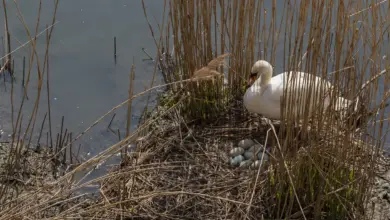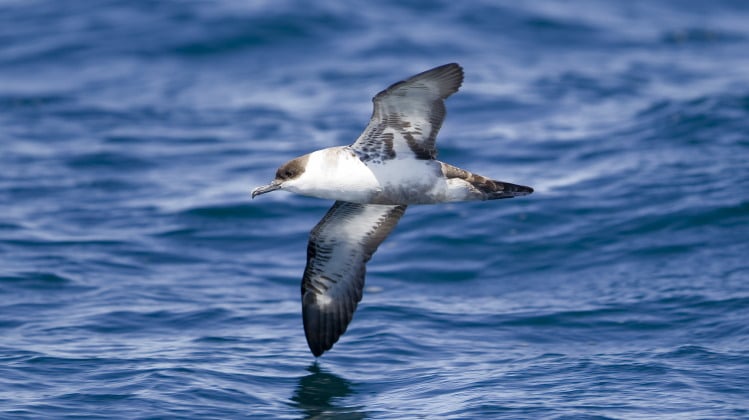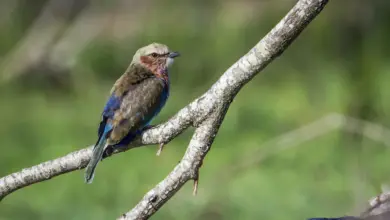380 Years Of Extinct Birds – Including The Infamous Dodo & Great Auk
380 Years Of Extinct Birds
Extinction was forever… once.
But modern biologists are doing their best to unravel the mysteries of DNA coding and cloning, so that extinct species may one day be able to be brought back into the world.
Nevertheless, until that time extinction still represents a loss of both a species and their genetic material.
There are many extinct birds in the history of our planet, far more than currently exist.
This however has taken millions of years and we have good reasons to believe that for life on earth altogether, on average, the number of species going extinct has been less than the number of species coming into existence.
However, the fossil record suggests that in the past, birds have been at times more numerous in species than they are now.
Recently though, mankind has had a dramatic effect on the rate and nature of extinctions occurring.
Mankind and Extinction
Through habitat destruction, the introduction of non-native species and deliberate hunting we have brought many species to extinction (long before when they would have become extinct had we not evolved the technology which has made this possible).
In the last 280 years, 42 species and 44 subspecies of birds are known to have become extinct.

Subspecies are important because they are the root stock from which species evolve. They are quite probably the species of the future. Many of these species have been island endemics with small ranges and small populations.
North America has seen 2 bird species and 3 subspecies go extinct in the last 200 years whereas Hawaii has lost 9 species and 7 subspecies in the same time.
There is little we can do about those species which are already gone, but by practicing a philosophy of personal awareness – combined with an abhorrence for the manifestations of greed and ignorance – we can perhaps play a part in slowing down the destruction of this precious diversity of beauty and life.
On this page I have chosen to supply a few examples which I think highlight the major problems facing both birds and those people who are fighting to save them.
Oh, plus supply a reasonably complete list of extinct birds from the last 380 years or so. Let’s start with the dodo.
The Dodo Bird
The most famous of the recently extinct birds is of course the Dodo.
One of 3 fairly similar, large, flightless birds living on the Mascarene Islands off the coast of Madagascar, which became extinct as a result of hunting and the depredations of rats, cats, pigs and macaques… all of which were introduced by early travelers.
The three birds were, the Dodo from Mauritius, the Solitaire of Reunion and the Solitaire of Rodriguez
The Dodo, Raphus cucullatus
Was extinct by 1680, only 174 years after Europeans first became aware of it.
No whole dodo birds are known but a selection of bones, including a whole head and a foot are in various museums around Europe. The bill was 9 inches, 22-25 cm long and it is believed the bird may have weighed as much as 50 lbs.
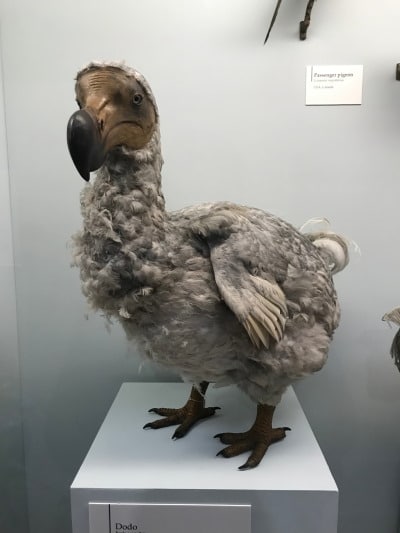
There are several descriptions and drawings of the dodo, which indicate a greyish bird with a lighter breast. Feet and legs yellow. The plumage may of course have changed seasonally, as do many birds.
Reunion Solitaire or White Dodo (Raphus solitarius)
Is known only from paintings and descriptions. Like the Rodriguez Solitaire the exact date the bird became extinct is not known. Bary de Saint Vincent visited the Island in 1801 and reported that no White Dodo had been seen for some time.
These 3 islands between them were home to many more birds than these, most of them endemic and completely unique.
Of the 28 fairly certain species of birds found on these islands, 27 were found nowhere else in the world… and of these 24 or 25 are now extinct. This is a terrible testament to the destruction human beings can unleash, even without modern weapons of mass destruction.
It is pointless however to be bitter, or to hate those responsible. We all make errors, in our ignorance. Like children learning as we grow, we can let this tragic history be a strong lesson on how precious the diversity of life on this planet is.
As well as one on how important it is to seek a growing awareness of the effects our actions have on the world around us, both as individuals and as a species.
The Moa Bird
The Moas of New Zealand are a good reminder of the fact that man is not the only factor involved in extinctions (although he might be the only one capable of bringing them back from the dead.)
Moas existed in New Zealand from at least the late Miocene or early Pliocene and the oldest known fossil is Anomalapteryx antiquus.
About 20-25 species are known from the fossil record. All are relatively large, flightless birds. The species thought to have died out last is Megalapteryx diderius, which some authorities claim existed on the South Island until about 300 years ago.
The Maoris arrived in New Zealand around 1350 AD, so this would mean that the Moas became extinct about 300 years after the Maoris arrived. Some authorities however maintain that all the Moas were extinct before the Maoris arrived. There were human inhabitants of New Zealand before the Maoris arrived and there is no doubt that they killed and ate both Moas and their eggs.

However, the New Zealand climate had been changing steadily for several thousands of years, becoming much wetter and causing changes in vegetation. Slowly the grasslands that the Moas evolved in had been replaced by forests.
Most authorities agree that this was an important factor in the decline of the Moas. It may well have been that human hunting and firing/burning of the remaining grasslands merely hastened the process of extinction, that the rest of nature had already been working towards in its own inevitable way.
The Great Auk (Alca impennis)
Last known specimens killed at Edley Rock, Iceland in 1844.
The Greak Auk was a large flightless seabird feeding on fish and eels and nesting on a number of rocky islands in the north Atlantic. Particularly Gunk Island, where the last known breeding colony was exterminated between 1785 and 1841.
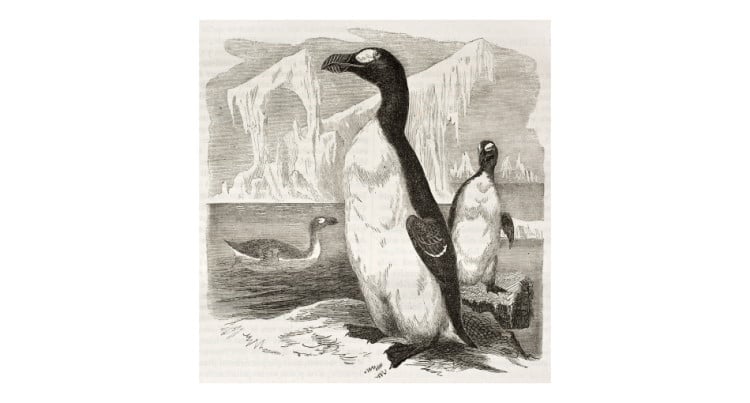
The birds were killed by seamen for food and by fishermen for food and for use as bait.
The largest of the Auks, Great Auks measured about 30 inches (75 cm) long with a black head and back and white front. The bill was large, as in all Auks, and their feet webbed. They had a white spat before the eye on either side of the face. Wings dark brown with secondaries having white tips. Eye chestnut.
The white spat was only present in summer and the dark brown/black of the chin and throat are white. Breeding probably occurred from May-July when the female laid one egg, incubation took about 30 days – we really know very little about it.
The Hawaiian Drepanididae
This family has suffered an incredible depredation in the Hawaiian Islands with 6 species and 4 subspecies suffering extinction in the last couple of centuries, including the Great Auk above.
Layson Honeyeater Himatiore sanquinea
Extinct since about 1923, when the last 3 specimens were seen by the Tanoger Exhibition of the US Biological Society.
Several searches were made in the 30s and 40s, but no further birds were found. Their extinction was a result of habitat destruction resulting from the introduction of rabbits to Layson Island in 1903 for commercial reasons. The birds (redbirds as they were known) were endemic to Layson Island.
Ula-Ai-Hawane Aridops anna
Extinct. An endemic to the island of Hawaii, the last specimen was caught on 20 February 1892 on Mount Kohala. This was a small finch-like bird predominantly black and grey in colouration, with a reddish rump. It lived in mountain forests.
Psittirostra, 3 species (palmeri, flaviceps and kona)
With another 2 species (P. psittacea and P. bailleui) being extremely rare and endangered. All have extremely solid, large seed-cracking beaks.
P. palmeri. Presumed extinct. The last reliable record is in 1896. It was found only in Koa forests of Hawaii at about 4000 feet elevation. It was the largest of the group measuring 8.5 inches long. The bird was easily recognised because of its colourful plumage, the male had a orange head, olive back, pale orange rump and yellow breast and belly – females similar except head yellow and back greener.
P. flaviceps. Extinct, another endemic to Hawaii, the last specimen was seen in October 1891. Physically the bird was similar to P. palmeri but smaller lived on the same Koa forests. It fed on seeds.
P. kora. Extinct, last seen in 1894 when they were already rare and restricted to an area about 4 miles square on the island of Hawaii. They were known to feed on the dry fruits of the Bastard Sandalwood trees. They were about 7 inches long, olive-green with a very large bill.
Common mamo Drepanis pacifica
Extinct, last seen in 1898 at above the town of Hilo in Hawaii.
An attractive bird with a long thin downward curving beak. Trapped regularly by the natives for its feathers. It is however likely, that as with the other species in this group, that habitat destruction, introduced predators, and disease were primarily responsible for its extinction.
Feathers almost entirely black except for a few yellow feathers on rump, wing and under-tail coverts. Fed on nectar.
Black mamo Drepanis funerea
Extinct. Last specimen taken in 1907.
Confined to the island of Molokai. Similar to the above D. pacifica except no yellow and with a hint of grey on the outer edges of the primaries. Fed on nectar. Introduced brown rats and mongooses are the presumed causes of extinction.
Passenger Pigeon, Ectopistes migratorius
About 12 inches long and typical pigeon shape and colours. Rump and upper tail covets Bluish Grey, Upper back with some iridescent remiges, lower back and wing covets brownish grey. Secondaries browner grey, primaries similar to secondaries but with a clear white edge.
Tail feathers white, except for the middle 2 which were grey. Breast cinnamon-rufous in upper parts, becoming paler on lower. Bill black, feet red, eyes orange. Wing length 196-214 mm, tail 173-211 mm.
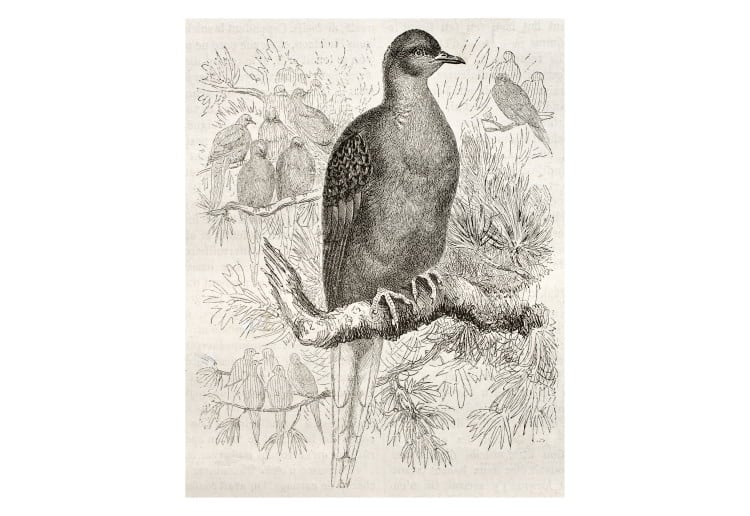
This bird lived mainly in deciduous forests in what is now mainland USA, exhibiting a North/South migration every year. With the summer northerly limit being southern Canada, Manitoba, Ontario and Quebec and the southern limit being Appalachians in north Virginia SW to northern Mississippi. Winter northerly limit was Indiana, Pennsylvania and Massachusetts normally, and southern limit being the Gulf of Mexico though stray birds were recorded in Bermuda and even Europe.
The most unusual thing about this now extinct bird was its colonial nesting and the huge flocks it used to migrate in.
Reasonable estimates suggest 2,000 million birds in one flock. So the populations in N. America was not small. The population appears to have undergone periodic fluctuations, with some years of excessive numbers where nesting sites were measured in hundreds of square miles – and years in between of less extreme numbers.
Insufficient data are available to explain these fluctuations but they undoubtedly contributed to the ease with which this once extremely numerous bird was extirpated.
Last specimen (named Martha) died on September 1914 in Cincinnati (Ohio) Zoological Gardens. The last certified wild specimen was taken between September 9-15 1899.
The bird was a herbivore, feeding mostly on oak and beech mast as well as seeds and fruits of other deciduous trees. It only ever laid one egg per season in captivity, though there are reports of it laying two eggs per nest at least occasionally in the wild.
Bonin Wood Pigeon, Columba versicolor
Extinct since 1889. Last specimen taken on the Japanese Island of Nakondo Shima.
A pale wood pigeon with a metallic, golden-purple back and head, green neck and rump. Feeding and ecology similar to most wood pigeons. It was endemic to just a few islands in the Baum Island archipelago south of Japan, Nakondo Shima, Peel Island and Kittlitz.
It is believed that habitat destruction was the main cause of extinction.
Tahitian Sandpiper, Prosobonia leucoptera
Extinct since probably the late 1700s early 1800s, this species was/is known from only one specimen in a museum in Leyden, Holland.
It was a small 7 inches long, dark brown bird turning rusty on lower portions. It was an endemic of Tahiti and Eimes and apparently frequented small streams. It is believed that it was the introduction of rats and pigs to the islands where it lived that caused its demise.
Crested Sheldrake or Shelduck, Tadorna cristata
Extinct (probably), last seen 1916 when a specimen was taken near Fusan, Korea.
Searches in more recent years have failed to find any other specimens. It is not known what its full range was, it was known from Korea and Japan and was painted by Japanese artists. It is supposed to have bred in eastern Siberia.
Similar in size to the common shellduck/drake (Tadorna tadorna), it had a distinctive head, green on top and grey below in the male and black on top whitish below in the female. Otherwise it had a green lower need and upper chest, the rest of the chest, the back and the belly being dark grey otherwise similar to a common Sheldrake. That is the male.
The female differs by having a black ring around the eye. No opinions have been offered that I know of to explain its extinction, though hunting must be a prime candidate.
The Cuban Red Macaw = Guacamayo = Ara tricol
Now extinct, it was last seen in 1864.
An endemic to Cuba, it was small, 20 cms long, mostly red and yellow with some blue and purple. They lived in the vicinity of the Zapata Swamp and nested in holes in palm trees. Though the natives were believed to eat them, no reasons are recorded for their extinction.
Guadeloupe Island Caracara Polyborus lutosus
Last seen 1 December 1900, this was a large brown hawk endemic to Guadeloupe.
It had a black head and a grey tail and is believed to have descended from Polyborus prelutosus. It was a generalist predator and fed on anything that was available from insects, worms and shellfish to small birds and mammals.
The natives bred goats and believed that the birds killed the kids, so for this reason the natives hunted it ruthlessly. In the 1800’s guns and poisons became easier and cheaper to acquire – and gave the natives the ability to exterminate the birds.
This is one of the few, if not the only, case of a bird species being deliberately brought to extinction. In this case, it is perhaps ironic that the goats – whose extermination this was all designed to protect – were an introduced species already doing considerable damage to the environment.
Mysterious Starling Aplonis mavornata
This extinct bird is known on from one specimen in the British Museum.
Nothing is known of it except that it was probably collected on one of Captain Cook’s voyages. It is not even known which Pacific Island it lived on, though now it is found on none.
List of Recently Extinct Birds
(species with an * may yet still survive)
| Common Name | Scientific Name | Distribution | Ex-Date |
|---|---|---|---|
| Burley Lesser Moa | Eurapteryx gravis | New Zealand | 1640 |
| Great Elephantbird | Apyornis maximus | Madagasca | 1650 |
| ascension Flightless Crake | Atlantisia elpenor | Ascension Is. | 1656 |
| Dodo | Raphus cucullatus | Mauritius | 1665 |
| Brawny Great Moa | Dinornis torosus | New Zealand | 1670 |
| Mauritius Parrot | Lophopsittacus mauritianus | Mauritius | 1680 |
| Red Rail | Aphanapteryx bonasia | Mauritius | 1693 |
| Mascarene Coot | Fulica newtoni | Reunion Is. Mauritius | 1693 |
| Mauritian Duck | anas theodori | Reunion Is. Mauritius | 1696 |
| Mauritian Shelduck | alopochen mauritianus | Mauritius | 1698 |
| Reuinon Dodo | Raphus solitarius | Reuinion Is. | 1715 |
| Rodrigues Pigeon | Alectroenas rodericana | Rodrigues Is. | 1726 |
| Rodrigues Little Owl | Athene murivora | Rodrigues Is. Mauritius | 1726 |
| Rodrigues Island Starling | Rodrigues Is. Mauritius | 1726 | |
| Rodrigues Night-heron | Nycticorax megacephalus | Rodrigues Is. Mauritius | 1761 |
| Rodrigues Rail | aphanapteryx leguati | Rodrigues Is. Mauritius | 1761 |
| Rodrigues Parrot | Necropsittacus rodericanus | Rodrigues Is. | 1761 |
| Rodrigues Solitaire | Pezophaps solitarius | Rodrigues Is. | 1765 |
| Mauritius Grey Parrot | Lophopsittacus bensoni | Mauritus | 1765 |
| Reunion Flightless Ibis | Borbonibis latipes | Reunion Is. Mauritius | 1773 |
| Thahiti Sandpiper | Prosobonia leucoptera | Tahiti | 1773 |
| Raiatea Parakeet | Cyanoramphus ulietanus | Raiatea Is. Tahiti | 1773 |
| Mysterious Starling | Aplonis mavornata | Raiatea (Society Is.) | 1774 |
| Kangaroo Island Black Emu | Dromaius diemenianus | Kangaroo Is. S. Australia | 1803 |
| Kosrae Crake | Aphanolimnas monasa | Caroline Is. | 1827 |
| Kittlitz’s Thrush | Zoothera terrestris | Bonin Is. Japan | 1828 |
| Kosrae Mountain Starling | Aplonis corvina | Caroline Is. | 1828 |
| Townsend’s Finch | Spiza townsendi | USA | 1833 |
| Lord Howe Purple Gallinule | Porphyrio albus | Lord Howe Is. Australia | 1834 |
| Mascarene Parrot | mascarinus mascarius | Reunion Is. | 1834 |
| Snail-eating Coua | Coua delandei | Madagascar | 1834 |
| Hollandais Pigeon | Alectroenas nitidissima | Mauritius | 1835 |
| Oahu Oo | Moho apicalis | Oahu Is. Hawaii | 1837 |
| Chatham Island Banded Rail | Rallus dieffenbachii | Chatham Is. New Zealand | 1840 |
| RyuKyu Kingfisher | Halcyon miyakoensis | Ryukyu Is’. Japan | 1841 |
| Great Auk | Alca impennis | North Atlantic Is. | 1844 |
| Black-fronted Parakeet | Cyanoramphus zealandicus | Tahiti | 1844 |
| Norfolk Island Kaka | Nestor productus | Phillip Is. Australia | 1851 |
| Speckled Cormorant | Phalocrocorax perspicillatus | Beringa Is. USSR | 1852 |
| Jamaican Least Pauraque | Siphonorhis americanus | Jamaica | 1859 |
| New Caledonia Lorikeet | Charmosyna diadema | New Caledonia | 1860 |
| Kioea | Chaetoptila angustipluma | Hawaii | 1860 |
| Reunion Island Starling | Fregilupus various | Reunion Is. | 1860 |
| Himalayan Mountain Quail | Ophrysia superciliosa | Himalayas | 1868 |
| Seychelles Alexandrine Parrot | Psittacula wardi | Seychelles | 1870 |
| Stephen Island Wren | Xenicus lyalli | New Zealand | 1874 |
| Labrador Duck | Camptorhynchus labradorius | Canada USA | 1875 |
| New Zealand Quail | Coturnix novaezelandiae | New Zealand | 1875 |
| Rodrigues Ring-necked Parakeet | Psittacula exsul | Rodrigues Is. | 1876 |
| New Caledonian Owlet-frogmouth | Aegotheles savesi | New Caledonia | 1880 |
| Hawaiin Rail | Porzana sandwichensis | Hawaii | 1884 |
| Cuban Red Mawcaw | Ara tricolor | Cuba | 1885 |
| Bonin Wood Pigeon | Columba versicolor | Bonin Is. Japan | 1889 |
| Bonin Grosbeak | Chaunoproctus ferreorostris | Bonin Is. Japan | 1890 |
| Lesser Koa-finch | Rhodocanthis flaviceps | Hawaii | 1891 |
| Ula-ai-hawane | Ciridops ana | Hawaii | 1892 |
| Kona Grosbeak | Chloridops kona | Hawaii | 1894 |
| Greater Koa-finch | Rhodocanthis palmeri | Hawaii | 1896 |
| Hawaii Mamo | Drepanis pacifica | Hawaii | 1899 |
| New Zealand Little Bittern | Ixobrychus novaezelandiae | New Zealand | 1900 |
| Gaudalupe Caracara | Polyborus lutosus | Guadalupe | 1900 |
| Chatham Island Rail | Rallus modestus | Chatham Is. New Zealand | 1900 |
| Greater Amakihi | Hemignathus sagittirostris | Hawaii | 1900 |
| New Caledonia Wood Rail | Tricholimnas lafresnayanus | New Caledonia | 1904 |
| Solomon Island Crowned Pigeon | Microgoura meeki | Solomon Is. | 1904 |
| Auckland Island Merganser | Mergus australis | New Zealand | 1905 |
| Pipio or New Zealand Thrush | Dicaeum quadracolor | New Zealand | 1906 |
| Black Mamo | Drepanis funerea | Molokai Is. Hawaii | 1907 |
| Huia | Heteralocha acutirostris | New Zealand | 1907 |
| Samoan Woodhen | Gallinula pacifica | Samoan Is. | 1908 |
| Slender-billed Grackle | Quiscalus palustris | Mexico | 1910 |
| Gaudalupe Storm-petrel | Oceanodroma macrodactyla | Guadalupe | 1912 |
| Passenger Pigeon | Ectopistes migratorius | USA | 1914 |
| Carolina Parakeet | Conurposis carolinensis | USA | 1914 |
| Red-moustached Fruit-dove | Ptilinopus mercierii | Marquesas IS. | 1922 |
| Laysan Millerbird | Acrocephalus familiaris | Laysan Is. Hawaii | 1923 |
| Layson Honeyeater | Himatiore sanquinea | Hawaii | 1923 |
| Norfolk Island Starling | Aplonis fusca | Norfolk IS. Australia | 1925 |
| Canarian Black Oystercatcher | Haematopus meadewaldoi | Canary Is. | 1931 |
| Hawaii Oo | Moho nobilis | Hawaii | 1934 |
| Pink-headed Duck | Rhodonessa caryophyllacea | India | 1935 |
| Ryukyu Wood Pigeon | Columba jouyi | Ryukyu Is. Japan | 1936 |
| Grand Cayman Thrush | Turdus ravidus | Grand Cayman Is. | 1938 |
| Laysan Rail | Porzanula palmeri | Laysan, Hawaii | 1944 |
| Wake Island Rail | Rallus wakensis | Wake Is. USA | 1945 |
| Glaucous Mawcaw | Andorhynchus glaucus | Brazil, Uraguay | 1955 |
| Pohnpei Mountain Starling | Aplonis pelzelni | Caroline Is. | 1956 |
| Four-coloured Flowerpecker | Turnagra capensis | Cebu Is’ Philippines | 1963 |
| Kakawihie | Paroreomyza flammea | Hawaii | 1963 |
| Crested Sheldrake* | Tadorna cristata | Korea, Japan | 1971 |
| New Zealand Bush Wren | Xenicus longipes | New Zealand | 1972 |
| Columbian Grebe | Podiceps andinus | Columbia | 1977 |
| Atitlan Grebe | Podilymbus gigas | Guatemala | 1980 |
| Alaotra Grebe | Tachybaptus rufolavatus | Madagascar | 2010 |
| South Island Tokoweka | Megalapteryx didinus | New Zealand | ca. 1785 |
| Chatham Island Swan | Cygnus sumnerensis | Chatham Is. New Zealand | pre 1690 |
| Mauritius Night-heron | Nycticorax mauritianus | Mauritius | pre 1700 |
| Tristan Moorhen | Gallinula nesiotis | Tristan da Cunha | pre 1900 |
| Lord Howe White-eye | Zosterops strenua | Lord Howe Is. Australia |
Final Thoughts
Well, I hope this has been an illuminating look at the all the birds that have gone extinct over the last 380 years or so. Perhaps now you’d like to check out…
Moa/Dodo image credit: Editorial credit: rook76 / VV Shots / Shutterstock.com



